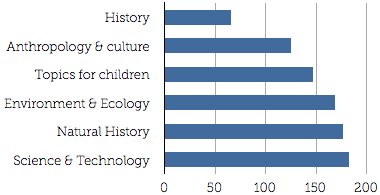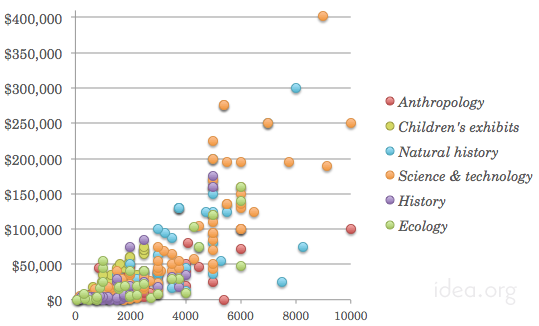Community Embraces New Word Game at Mid-Year Play Day This past Sunday, families at Takoma Park’s Seventh Annual Mid-Year Play Day had the opportunity to experience OtherWordly for the first time. Our educational language game drew curious children and parents to our table throughout the afternoon. Words in Space Several children gathered around our iPads […]
Read moreCategory: Learning & access
Computers and the internet are an increasingly important way that Americans engage in the arts, says a new report from the National Endowment for the Arts. The first bar in the chart below is people consuming recorded or broadcast content:
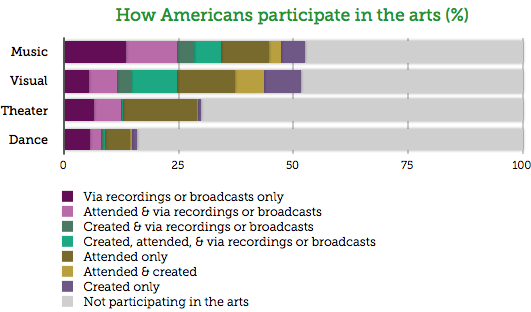
 America’s teachers are paying $480 million dollars out of their pockets to feed our kids. Earlier this week, Share Our Strength, a nonprofit working to end childhood hunger in America, reported that “61% of teachers who see children coming to school hungry because they are not eating at home purchase food for their classrooms, at an average of $25 a month.”
America’s teachers are paying $480 million dollars out of their pockets to feed our kids. Earlier this week, Share Our Strength, a nonprofit working to end childhood hunger in America, reported that “61% of teachers who see children coming to school hungry because they are not eating at home purchase food for their classrooms, at an average of $25 a month.”
 Patrons at 150 local libraries have a new option to borrow eBooks on their computers or iPad. Yesterday, Internet Archive launched a cooperative of libraries who are pooling resources to make eBooks available to their patrons. Patrons can now borrow any of 9,313 eBooks which have been purchased or scanned by any of the participating libraries. (more…)
Patrons at 150 local libraries have a new option to borrow eBooks on their computers or iPad. Yesterday, Internet Archive launched a cooperative of libraries who are pooling resources to make eBooks available to their patrons. Patrons can now borrow any of 9,313 eBooks which have been purchased or scanned by any of the participating libraries. (more…)
Online video gained momentum in 2010, says a recent report from comScore. Compare 2009 and 2010:
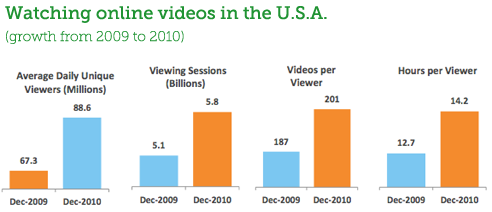
More people are using fast smartphones, and expect to get their information on their phones. In the last quarter of 2010, approx 95 million smartphones shipped worldwide. Are you ready to reach these people? Following are some graphs relevant to how the public gets information:
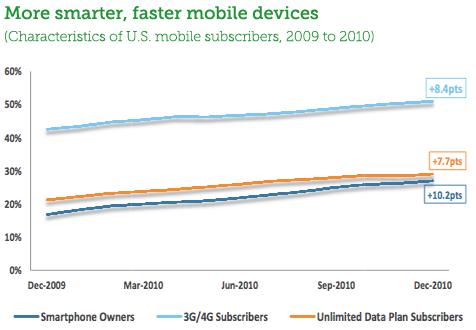
Tablets are hot, and here to stay, says a new 100-page report from financial firm, Morgan Stanley, which predicts the tablet market will be huge, shipping more than 100 million units by 2012. The growth rate is higher than any other mobile device in history, and will reshape learning. The following charts the total cumulative shipments* in the first 5 years of other mobile devices, and projected growth of the tablet. In millions:


Real life has a close competitor in the “Art Project,” released by Google last week. Their initial release is a clean, inviting site for browsing over one thousand artworks from 17 of the world’s most famous museums. At least one piece from each of the 17 museums is displayed in gigapixel resolution, so that online visitors can zoom in to the brushstrokes. Each piece also has information about the artists, text or video commentary, bios, and links to related pieces. Some museums have 3D walk-throughs, analogous to Google’s map street views (there are 6000 3D panoramas), and there’s a way to create personal art “collections” to revisit or share later.
 Mobiles and eBooks will be a big deal in higher education by the end of the year, predicts a panel of 42 experts in education, technology, and business in a new report jointly released by a consortium and association related to higher education. These predictions are gathered in the “2011 Horizon Report,” released today.
Mobiles and eBooks will be a big deal in higher education by the end of the year, predicts a panel of 42 experts in education, technology, and business in a new report jointly released by a consortium and association related to higher education. These predictions are gathered in the “2011 Horizon Report,” released today.
Also, coming soon, these experts predict that by 2014, augmented reality and game-based learning will be important. And by 2016, they predict students will often use gestures to interact with computers, and that learning analytics will be common.
The costs to rent a traveling exhibit vary widely depending on the size, complexity, subject matter, and underlying objectives of exhibition owners.
To visualize the diversity of costs, we look at the Traveling Exhibitions Database (TED). It includes a database of 768 current traveling exhibitions available in the U.S. The following is the distribution of sizes (square feet) vs. costs ($USD) of traveling exhibits:
What kinds of traveling exhibits are there? A lot. The Traveling Exhibitions Database (TED) is a database of 768 current traveling exhibitions which are available to U.S. museums. Here’s how they are distributed by category:
